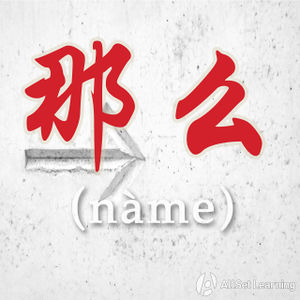Difference between revisions of "Expressing "then…" with "name""
| Line 39: | Line 39: | ||
[[Category:Connectors]] | [[Category:Connectors]] | ||
{{Similar|Explaining results with "suoyi"}} | {{Similar|Explaining results with "suoyi"}} | ||
| + | {{Similar|Cause and effect with "yinwei" and "suoyi"}} | ||
{{Basic Grammar|那么|B1|那么……|<em>那么</em>,我们 怎么 办?|grammar point|ASGX298Z}} | {{Basic Grammar|那么|B1|那么……|<em>那么</em>,我们 怎么 办?|grammar point|ASGX298Z}} | ||
{{Rel char|那}} | {{Rel char|那}} | ||
{{POS|Conjunctions}} | {{POS|Conjunctions}} | ||
{{Used for|Connecting ideas}} | {{Used for|Connecting ideas}} | ||
Revision as of 09:17, 27 September 2012
-
Level
-
Similar to
-
Used for
-
Keywords
Structure
When expressing "Then...", you can use "那么" (nàme) in order to begin a judgment or result from previous context. An example of this in English would be "Then, what should we do?"
Context + 那么 + Result
Examples
Here are some examples of 那么 being used in this way.
- 既然 大家 都 不 同意 这 个 做法,那么 ,再 跟 经理 讨论 一下 吧。
- 十五路 公共 汽车 已经 没有 了,那么 ,我们 怎么 回家?
- 我 的 文章 的 初稿 真 不 太 好,那么 ,明天 我 怎么 交 论文 呢?
See also
Sources and further reading
Books
- Integrated Chinese: Level 1, Part 1 (3rd ed) (pp. 104-5) →buy
- Integrated Chinese: Level 2, Part 1 (pp. 51-2) →buy
- New Practical Chinese Reader 4 (新实用汉语课本4) (pp. 103) →buy



